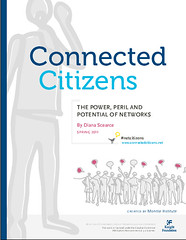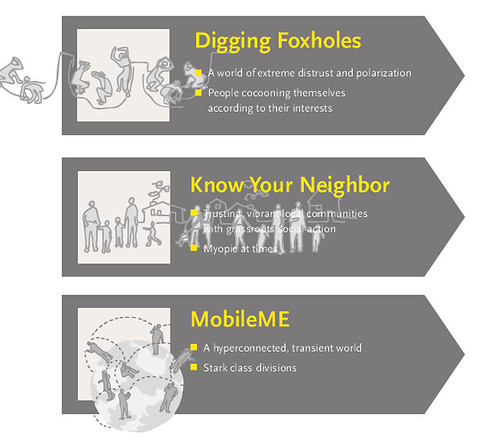
Knight Foundation and Monitor Institute published a new report called “Connected Citizens” that looks at the impact of networks on communities, and asks, what do these emerging networks mean for community change? And, how can funders leverage them for good? The report analyzes many examples of networks and provides tools and tips for Network-Centric Grantmaking. Diana Scearce, who I’ve had the pleasure of working with on the Network of Networked Funders project, is the report author.
The report is pure gold. If you are interested in social change and the way that networks help realize change, you must stop what you’re doing and read this report now. Here’s a summary of a few of my favorite parts and framing.
Seeds of the Future: Connected Citizens Today
The report opens with a look at current practices of using networks for citizen-centered social action that are promising for the future. The opening chapters include many stories about networks and collective action and pull out key themes and strategies. In addition to the stories, you’ll find additional resources related to each theme. These themes include:
1. Listening to and consulting the crowds: Actively listening to online conversations and openly asking for advice.
2. Designing for serendipity: Creating environments, in person and online, where helpful connections can form.
3. Bridging differences: Deliberately connecting people with different perspectives.
4. Catalyzing mutual support: Helping people directly help each other.
5. Providing handrails for collective action: Giving enough direction for individuals to take effective and coordinated action.
This blog post at the Knight Foundation talks about designing for serendipity in more detail.
The report doesn’t just leave with current practice, it also covers some scenarios for the future. The scenarios are both possible and provocative. Discussions around these scenarios are useful to philanthropy in making decisions about where to invest in social change in the future. The premises and questions for the future include:
- Interconnectedness: People will have more connectivity and more information
- Decentralization and Individual Empowerment: As power is pushed to the edges, individuals will have an increasing ability to exert influence through social and broadcast media. We will be influenced by what our connections think and information production and distribution will become more participatory.
- Transparency: More information that’s accurate and inaccurate will be available for use and abuse, including more personal information and news.
The report asks a number of impact questions related to networked citizens and the future.
- How much trust or mistrust will there be?
- What will be the nature of public participation and conversation?
- What will be the impact of technology on civic engagement?
- What will be the nature of leadership in a networked world?
The report describes three possible scenarios in detail and analyzes the impact for social change an philanthropy. The scenarios describe how communities might be brought together or pulled apart, the ways in which citizens may be well-informed, or misinformed.

The last section of the report includes practical recommendations for funders on how to ignite and support networks. (I’ll have more on this in an upcoming blog post having just spent a couple days at a convening going deep on this topic.) This includes:
- Embrace a network-centric mindset – experiment with work practices that favor transparency, distributed leadership and working with whole systems.
- Support network-centric work through the smart allocation of resources
- Contribute to learning about what makes networks work and how funders can best participate and support.
The report also calls out some good tips and tools for network-centric grant making, including an assessment tool. More importantly, there is a list of pitfalls to avoid. These include:
- Don’t assume that creating network space alone won’t increase participation if there are still barriers like digital access
- Don’t invest in networks if you haven’t made a commitment to understanding the dynamics
- Don’t hire a person to be the “network leader.” Ultimately, networks are shared responsibility.
- Don’t push networks to centralize and create format structures in order to manage when the network does not need this structure
- Don’t assume that models of organizational effectiveness can be applied to strengthening networks
- Don’t use conventional evaluation criteria to assessing network impact
If this report leaves you itching to discuss the future of networks for social change in communities, the Knight Foundation is hosting a webinar for conversation at 2 p.m. EDT on April 20th (sign up and more info here) .

Leave a Reply